
Snake River and the Tetons, Ansel Adams, The Mural Project, 1942
Compare with modern photo of same scene at botton of page.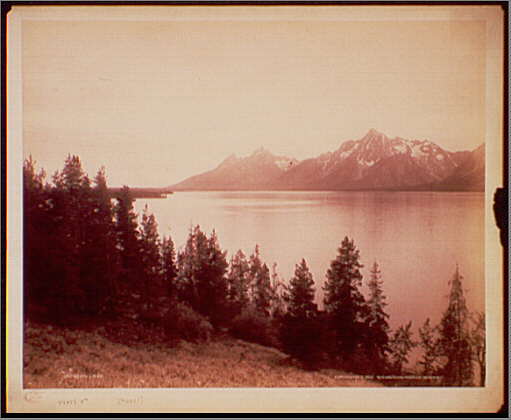 The Mural Project was commissioned in 1941
by Secretary of the Interior, Harold Ickes, to provide photographs of national parks, monuments, Indian
lands and reclaimation projects
under the jurisdiction of the Department. Because of World War II the project was
discontinued. The Mural Project was commissioned in 1941
by Secretary of the Interior, Harold Ickes, to provide photographs of national parks, monuments, Indian
lands and reclaimation projects
under the jurisdiction of the Department. Because of World War II the project was
discontinued.
John Coulter, a veteran of the Rogers and Clark expedition, is generally credited as the first white American to visit the valley
now known as Jackson Hole. The valley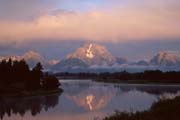 was named by William Sublette, a partner with Jedediah Smith and David E. Jackson in the purchase of the
Ashley Fur Company, after his partner. Trappers conducted regular rendezvous in Wyoming up to about 1845 when the fur trade ended.
The majority of the rendevous were held near Pinedale on the Green River, see below.
The valley next gained attention as
a result of the Hayden Expedition
of 1871 which included in its ranks William Henry Jackson, the photographer, 1902 tinted view of Lake Jackson by Wm. H. Jackson above right,
and Thomas Moran, a landscape artist, after whom
Hayden named Mt. Moran, to the left.
The first settlers in the Hole were John and Millie Carnes and John Holland. By the middle of the 1890's the villages of
Kelly, Wilson and Moran had been established. was named by William Sublette, a partner with Jedediah Smith and David E. Jackson in the purchase of the
Ashley Fur Company, after his partner. Trappers conducted regular rendezvous in Wyoming up to about 1845 when the fur trade ended.
The majority of the rendevous were held near Pinedale on the Green River, see below.
The valley next gained attention as
a result of the Hayden Expedition
of 1871 which included in its ranks William Henry Jackson, the photographer, 1902 tinted view of Lake Jackson by Wm. H. Jackson above right,
and Thomas Moran, a landscape artist, after whom
Hayden named Mt. Moran, to the left.
The first settlers in the Hole were John and Millie Carnes and John Holland. By the middle of the 1890's the villages of
Kelly, Wilson and Moran had been established.

Jackson, Wyoming, 1930's
To the left of the Telephone Office is the
"Blue Bird Cafe." The sign on end of the canopy on the Blue Bird advertises guest rooms.
The directional signs on the post point to Yellowstone Park and Moran Junction.
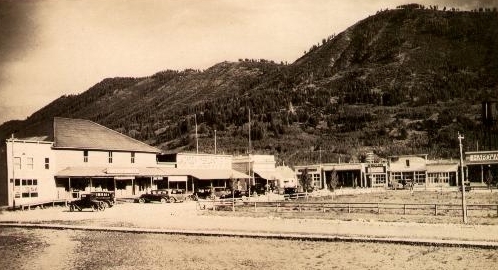
Jackson, 1920's
At the time of the above scenes Jackson had
a population of approximately 500, compared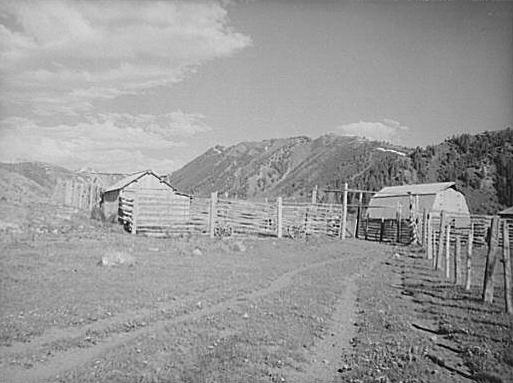 to approximately 4,500 today.
The hardware store at the left in the upper photo is at the right in the lower
photo. Jackson, the town, without the "Hole", was given its name by Maggie Simpson when she was
appointed post master and the post office
was moved to the Simpson homestead. In 1897,
the Town of Jackson was platted by the Simpsons and Robert and Grace Miller, with Grace doing the
drafting. The oldest existing frame building,
to approximately 4,500 today.
The hardware store at the left in the upper photo is at the right in the lower
photo. Jackson, the town, without the "Hole", was given its name by Maggie Simpson when she was
appointed post master and the post office
was moved to the Simpson homestead. In 1897,
the Town of Jackson was platted by the Simpsons and Robert and Grace Miller, with Grace doing the
drafting. The oldest existing frame building, built in 1916, in the town pictured lower left. The building was later
used as a bowling alley and now houses a playhouse.
built in 1916, in the town pictured lower left. The building was later
used as a bowling alley and now houses a playhouse. Grace Miller later became noted
by being elected Mayor in 1920
when an all woman town government was elected. Both Sen. Alan K. Simpson and his father, Gov. Milward Simpson,
are descendants of the pioneer Simpson family of Jackson. The Miller homestead became the site of the National Elk Refuge. Robert Miller
was a major land agent for the Snake River Land Company, owned by the Rockefeller family, which
accummulated the land which was ultimately turned over to the government for the
Teton National Park. Up until the creation of the park much of the valley was given over to
agriculture, 1936 view of farm near Jackson by Arthur Rothstein, upper right.
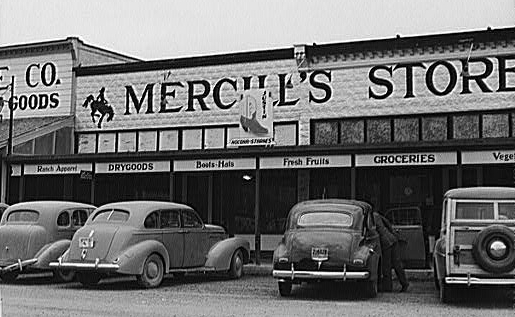
Jackson, 1941, photo by Marion Post Walcott
For discussion of Marion Post Walcott, see Sheridan II. Note that Mercill's
store sells everything from boots to vegetables. William Mercill (1888-1969) was
one of the men defeated for election in 1920 when the all woman city government
was elected. Mercill Avenue in Jackson was originally North Street. The name change
was officially confirmed by Resolution of the Town Council in 1998.

Snake River Overlook, 1997
|